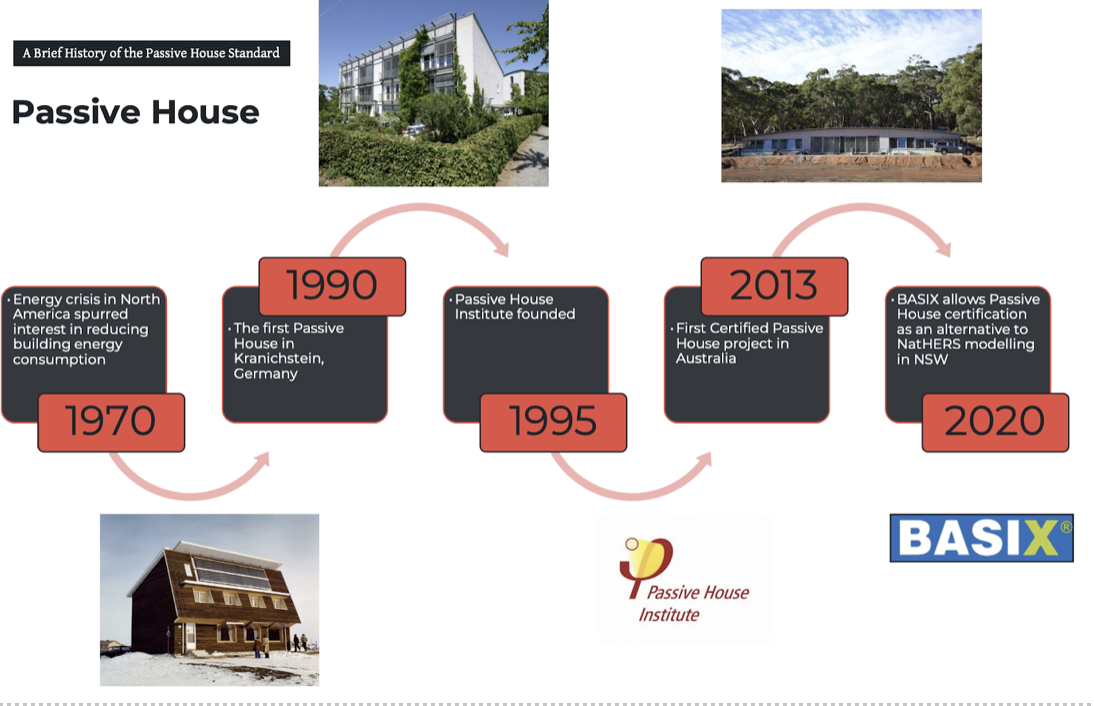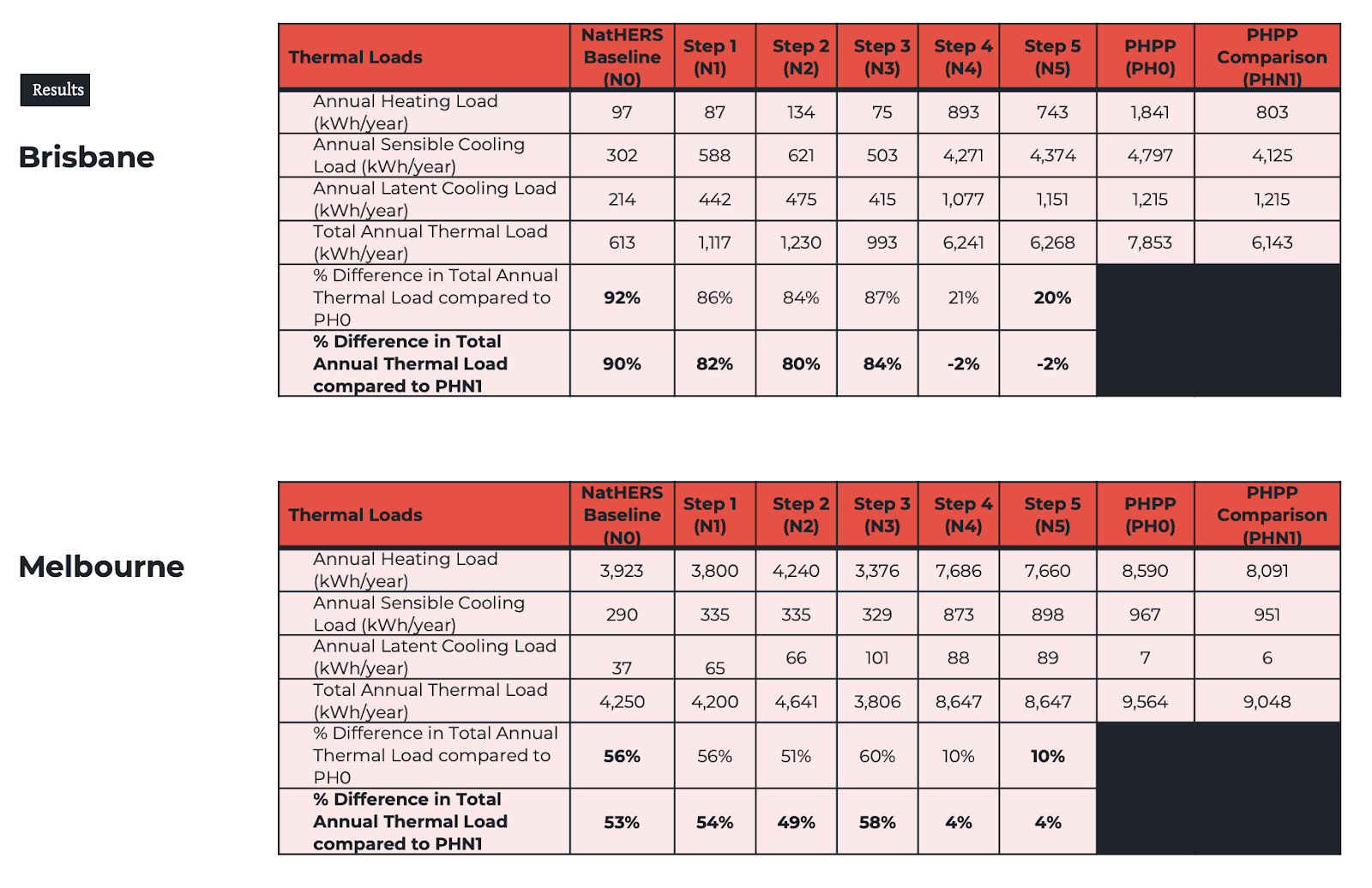NatHERS vs Passivhaus: Understanding the Differences
When it comes to residential energy efficiency building practices in Australia, two prominent rating schemes, stand at the forefront — Nationwide House Energy Rating Scheme (NatHERS) and the Passivhaus Standard.
Both have the same intent of predicting the annual heating and cooling demand, but each offers distinct approaches to assessing building energy performance. Despite their shared goal of promoting energy efficiency, the rating schemes diverge in their methodologies and criteria, leading to contrasting results and diverging design strategies.
In this article, we will explore the background of NatHERS and Passivhaus, what makes them different and explore research from Gregory Mason, Senior Sustainability Consultant at WSP, and MPhil Candidate in the University of Queensland School of Architecture, Design and Planning.
This research uncovers the differences between NatHERS and Passivhaus calculations and assumptions — and what this means in real world applications.
How NatHERS Became the Main Energy Rating Scheme in Australia
Source: Beyond NatHERS: How Australia Can Build Better Homes (Mason, 2024)
NatHERS stands as Australia's foremost energy rating system, shaping the nation's approach to sustainable building practices. At its core lies the Chenath engine — developed by the Commonwealth Scientific and Industrial Research Organisation (CSIRO) — a result of over six decades of energy modelling innovation.
This journey started in the 1950s with the inception of the CARE model, evolving steadily through subsequent decades until the birth of the Chenath engine in the '90s and '00s.
In 1993, NatHERS emerged as a voluntary initiative, leveraging the Chenath engine to provide comprehensive energy assessments for residential properties. With subsequent enhancements to the engine, NatHERS became the gold standard of code compliance within the Building Code of Australia in 2003. It has since progressively elevated minimum star ratings with the intent to incorporate energy-efficient design into the building code.
With the adoption of the NCC 2022, many states will mandate a seven-star rating, symbolising the nation's commitment to sustainable living
Passivhaus and Its Journey to Australia.
Passivhaus and Its Journey to Australia
Source: Beyond NatHERS: How Australia Can Build Better Homes (Mason, 2024)
While Australia was developing precursors to the Chenath engine during the '70s, North America and Europe were grappling with an energy crisis that spurred significant research into household energy consumption.
One notable milestone emerged in 1977 with the construction of the Saskatchewan Conservation House, a pioneering project embodying principles that would later underpin the Passivhaus (PH) standard.
Wolfgang Feist emerged as a pivotal figure following the energy crisis-driven research funding in the '80s and by 1990, he erected his first house based on the PH standard. Feist's efforts culminated in the establishment of the Passive House Institute in 1995, aimed at fostering innovation and research in building energy performance.
Although the PH movement took root in Europe, its influence gradually spread globally. In Australia, the first certified Passivhaus didn't materialise until 2013. However, in recent years, there has been a notable surge in PH constructions across the country, showcasing a growing interest in energy-efficient building practices.
In a significant move reflecting Passivhaus' recognition, the New South Wales Building Code Compliance Requirement, known as BASIX, embraced Passivhaus certification as an alternative to NatHERS modeling in 2020.
This pivotal decision underscores the increasing acceptance and relevance of Passivhaus principles in the Australian building industry.
Comparing NatHERS and Passivhaus
When comparing these two energy rating schemes at face value, it can be incredibly easy to make incorrect assumptions.
Looking at the tables below, some people may assume that achieving three NatHERS stars in Brisbane or Sydney automatically aligns with Passivhaus standards. While these assumptions may seem plausible at first glance, they come with hidden pitfalls.
Source: Beyond NatHERS: How Australia Can Build Better Homes (Mason, 2024)
At the heart of the matter lies the fundamental differences in the methodologies and criteria employed by these two modeling tools. That’s why it’s important to dive into the nuances of each standard to truly understand the results they provide as opposed to taking ratings at face value.
Understanding the Modelling Differences Between Passivhaus and NatHERS
Source: Beyond NatHERS: How Australia Can Build Better Homes (Mason, 2024)
PH employs the Passive House Planning Package (PHPP), a robust software designed to adhere to international best practices for conditioned buildings.
Central to PH principles is the maintenance of indoor temperatures between 20 and 25 degrees Celsius throughout the year, with a moisture content below 12 grams per kilogram translating to approximately 60% relative humidity at 25 degrees Celsius.
This stringent standard sets a consistent benchmark for energy efficiency, emphasising airtightness and minimising infiltration through building envelope sealing.
In contrast, NatHERS operates on an adaptive thermal comfort model tailored for naturally ventilated buildings. This approach triggers heating and cooling mechanisms when thermal comfort metrics are not met, allowing for flexibility in response to varying climatic conditions. Additionally, NatHERS calculates infiltration based on construction types, sealing of openings, and other inputs, forgoing a whole-building metric in rating mode.
One significant divergence lies in the heating and cooling set points. In NatHERS, they vary based on climate, zone type, and time of day. This complexity contrasts with the fixed set points utilised in PHPP, contributing to significant differences in energy estimations between the two systems.
The impact of these modelling differences becomes evident when comparing energy assessments generated by both schemes.
Passivhaus vs NatHERS Software Modelling Results
To conduct a thorough comparison, Gregory took a baseline NatHERS model and mirrored it in the Passive House Planning Package (PHPP), making adjustments to align the two as closely as possible.
Source: Beyond NatHERS: How Australia Can Build Better Homes (Mason, 2024)
The process involved adjusting the key NatHERS assumptions one by one. This included: removing ceiling fans, conditioning every zone as well as adjusting infiltration rates, heating/cooling set points, and internal gains.
The results revealed notable discrepancies between the initial NatHERS baseline and the PHPP model. Initially, the heating and cooling loads in NatHERS were a staggering 92% lower than in PHPP, highlighting significant differences in the underlying assumptions and calculations of the two software tools.
Source: Beyond NatHERS: How Australia Can Build Better Homes (Mason, 2024)
However, through the systematic adjustments to the NatHERS model, the disparity gradually narrowed. By fine-tuning the PHPP model to match NatHERS inputs as closely as possible, the gap closed significantly, with the final comparison showing just a 2% difference in energy estimations.
In the case of a well-designed house in Brisbane, achieving a high NatHERS rating of 9.1, the adjustments to meet Passivhaus standards resulted in an improvement to 10 stars. Similarly, in Melbourne, where the initial NatHERS rating was 6.4, aligning with Passivhaus principles led to a rating improvement at 8.4 stars.
Why the Base Results are so Different Between NatHERS and Passivhaus
Most homes in Australia were built prior to the adoption of energy efficiency requirements in the building code with many homes being traditionally uninsulated and rarely heated or cooled. Due to this, there hasn’t been a major focus on improving the building fabric of new and existing homes due to assumptions around how Australians condition and operate their homes.
The issue now is that most homes in Australia are using heating and/or air conditioning systems in homes that were never intended to be conditioned.
Source: Beyond NatHERS: How Australia Can Build Better Homes (Mason, 2024)
In Australia, while most home are equipped with heating or cooling systems, very few have any allowance for fresh air, beyond opening windows. As such, homes can be ventilated, or conditioned, but can’t do both efficiently.
In hot climates, whether we design for natural ventilation, or air conditioning, the ideal design is very different. Dr Steven Szokolay stated back in 1987 in his book, Thermal Design of Buildings the following:
“A building designed for passive cooling would be as open as possible, to ensure the maximum cross ventilation, consequently it would be totally unsuitable for air conditioning. If the building is to air-conditioned, a completely different design approach must be adopted. The result would be more similar to a cold climate design, in the sense that the building would be closed, sealed and well insulated.”
The NatHERS star bands are designed to promote a natural ventilation design, when the vast majority of homes are equipped with air conditioning in Australia’s warmest climates. Thus, is NatHERS actually resulting in improved energy efficiency in warm climates?
In a cold climate, the issue is simpler to fix, the heating set-points are set at 15C overnight in nighttime use spaces, and non-existent in daytime use spaces. This results in homes that are cold in winter (in Australia’s cooler climates) and does not reflect the true benefit of well-designed building fabric.
The Bottom Line on NatHERS vs Passivhaus
While both frameworks offer valuable insights into building energy performance, the assumptions built into their respective modelling tools shape their effectiveness in delivering sustainable, energy-efficient homes.
First and foremost, it's essential to acknowledge the strengths of NatHERS as a national framework for promoting energy efficiency. Despite its limitations, NatHERS provides a robust foundation for energy-efficient house design. However, it's important to recognise that the current modelling approach may pose challenges, particularly in the warm climates of Northern Australia.
On the other hand, Passivhaus standards offer a compelling solution by incorporating stringent construction requirements, including the verification of airtightness. This focus on ensuring that buildings are constructed as designed enhances the reliability and accuracy of Passivhaus assessments. Additionally, Passivhaus addresses concerns regarding thermal comfort by aligning temperature set points with World Health Organisation recommendations, prioritising the health and well-being of occupants.
Ultimately, the bottom line is that both NatHERS and Passivhaus play vital roles in advancing energy-efficient building practices in Australia. It's through this collaborative effort that we can strive towards a future where sustainable, net zero homes are the norm rather than the exception.
NOTE- this article is an adaptation of Gregory Mason’s presentation to the Australian Passivhaus Community, about his paper Beyond NatHERS: How Australia Can Build Better Homes (Mason, 2024)











